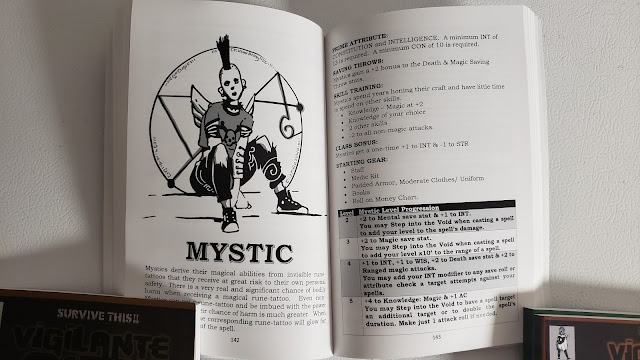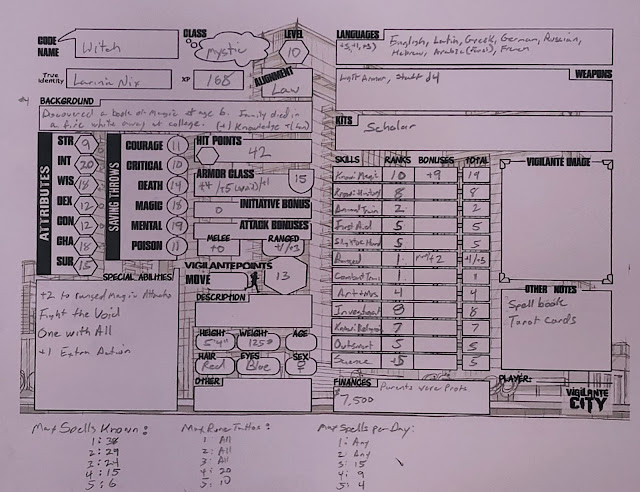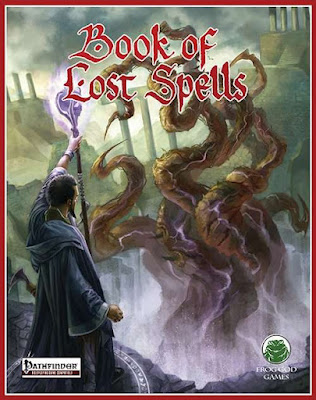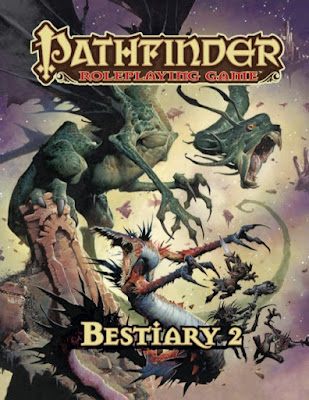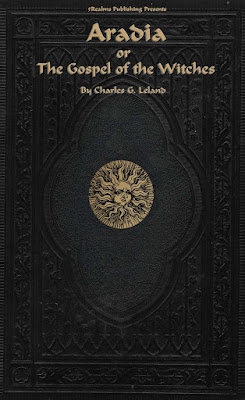PDF and softcover book. 292 pages. Color cover, black & white interior art. For the purposes of this review, I am considering the PDF from DriveThruRPG and the soft-cover books I picked up either via Kickstarter or from Bloat Games' own store.
Vigilante City, or more accurately, SURVIVE THIS!! Vigilante City #1 Core Rules, is a street-level supers game for the SURVIVE THIS family of games from Bloat Games. The same folks that gave us the awesome Dark Places & Demogorgons and the amazing We Die Young RPGs. So right away these rules feel familiar. But this game is more about teenage angst in the 80s and 90s. There are mean streets out there.
The game really is a great starter for anyone that has played D&D/OSR-like games and wants to get into a supers game. Like all SURVIVE THIS!! games this one in class and level with levels topping off at 10.
Right from the start, this game lets us know what it is all about. These are street-level supers. While there might the occasional mutant, anthropomorphic otter, Super Soldier, or power suit we will not be seeing the likes of Superman or Wonder Woman. This is Batman, Captain America, and Tony Stark down all the way to the Teenage Mutant Ninja Turtles and some guy with a baseball bat. If this sounds like your kind of game (and really who wouldn't want to play this?) then buckle in, because this is going to be fun.
The Core Rule book covers the basic hero classes (this is a class/level system derived from the SRD) and basic rules. I am going to point out here that the rules are very much the same as other Survive This!! games with notable areas to aid heroic play. While in the past I have pointed out that teens of the 80s in Dark Places & Demogorgons can grow up to become the young adults of the 90s We Die Young, there is no logical progression here from those games. To be fair that is also not the designer's intent. I *can* see a world that involves all these games (that and their newer What Shadows Hide line) but let's first appreciate this game for what it is right now and not what inhuman creation I'll make with it later.
The Basics
We start off with the basic rules, or maybe I should say "Basic" rules since these rules are designed from the d20 SRD to feel like old-school D&D, D&D Basic in particular. As mentioned before it shares this design with all the other Survive This!! games. You generate attributes, the usual six plus a seventh "Survival," you generate your saving throws, pick your alignments, calculate your Vigilante Points, work out your Origin/Background (every good hero has a backstory!) and then comes the time to choose your class.
Human Classes
Basic D&D's DNA is peaking through here. You have your normal human classes and then a section on "Mega Humans." But let us talk about humans first. Essentially these are the roles that an everyday, but not really average, human could pick up and say "I am going to fight crime as a ..." Yes a lot of these require training and/or to be born with the right genetic lottery (smart, rich, or both).
These classes are: Athlete, Crime Fighter, Dark Avenger, Gadgeteer, Genius, Hardboiled Detective, Knight Nurse, Martial Artist, Mentor, Mercenary, Protégé, Sharp Shooter, Street Preacher, and True Vigilante. Most, if not all are fairly self-explanatory. Each gets 10 levels of advancement where they gain certain advantages. Like the comics that inspired them the character classes are fairly 2-Dimensional. THIS IS APPROPRIATE. You fill in the blanks with your backgrounds and skills. You can choose "Street Preacher" but you have to figure out if you are Jacob Fuller (Harvey Keitel's character in "From Dusk til Dawn) or Jesse Custer from Preacher.
Mega-Humans
Much like the split between Demi-humans and humans in D&D, and Meta-humans/Mutants and humans in comics, we get our section on Mega-Humans. Mega humans are both a "species" and a "class" they can pick up skill packages to differentiate themselves, but largely this is what they are. Again, this fits the tone of the X-man comics.
Our Mega-Human classes are: Anthropomorphs, Borg, Mutant, Mystic, Powered Armor, Psion, Super Soldier, and Super Speedster. Lots of choices here.
These classes and their powers (spells for the mystic, psionics for the psion) cover the first 210 pages of or 2/3rds of this book. That is expected really.
The classes are followed with Skils & Skill Packs, XP/Leveling, Gear, Vehicles, Game Terms and Critical tables.
There is a solid index and the PDF is bookmarked.
The game has a feel of Villians & Vigilantes mixed with Mutants & Masterminds with the difficulty of Icons. Any veteran of either of those games will pick this one up fast. Anyone that has played D&D or other Survive This!! games will pick it up even faster. That is already given the fact that this is a quick and easy game to learn and play. There are groups out there that are searching for the perfect Supers game and this could very well be it for them. I find it very, very appealing.
Like all games from Bloat Games, there is a lot of support online and in other books for this line.
Larina Nix for Vigilante City
Give me a magic-using class and I am going to try it out with my Drosophila melanogaster of magic, Larina.
Given this is an old-school game I opted to go old school with dice, a printed character sheet, and a pencil. I spent longer troubleshooting my scanner than I did on this character build!
I like how she came out, to be honest. And I like how fast it was to create a 10th-level character too. I'll pick her spells later. I figure she would have access to all of them.
I'll do this for the other books in the series as well, adding what each book adds to the game. This will be quite fun really.
All I could think of while doing all of this was this song. So play us home Steve!



